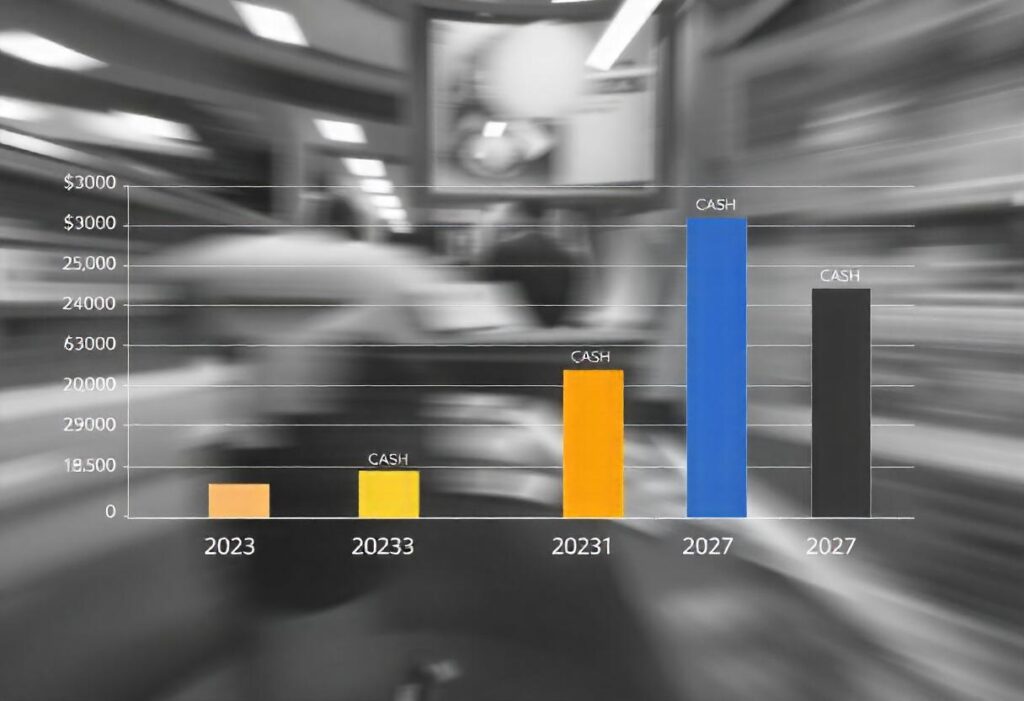Valentina Meneses, a Senior Project Analyst and Project Manager at Payments and Commerce Market Intelligence (PCMI), delivers a detailed examination of the payments and ecommerce trends currently seen in Peru.
In recent years, Peru’s payments sector has seen substantial growth attributed to a rising acceptance of digital payment methods and continuous technological advancements. Cash still holds the majority in transactions, representing 35% of point-of-sale (POS) payments in 2023 and 9% of ecommerce transactions through cash-based post-pay systems like PagoEfectivo, yet the environment is changing. By 2027, digital wallets and account-to-account (A2A) payments are anticipated to lead the way for POS and ecommerce, capturing 28% and 31% of market share, respectively.
The adoption of QR codes is driving this transformation, complemented by the popularity of applications like Yape and PLIN, along with government efforts to enhance financial inclusion. The following sections illustrate the profound changes occurring across various dimensions of Peru’s payments ecosystem.
Key Payment Trends in Peru: Technology Outshines Cash
Historically, cash has reigned as the primary payment method in Peru and across Latin America. However, the arrival of modern paytech options and a mandate from the nation’s central bank have considerably diminished its dominance—particularly as these alternatives gained traction during the pandemic.
Yape and PLIN’s Rising Popularity: Yape, launched by Banco de Crédito del Perú (BCP) in 2016 as a peer-to-peer (P2P) payment solution, represented a pivotal moment for digital wallets in the country. Created to enhance financial inclusion and lessen reliance on cash, Yape allows users to send money simply using mobile numbers, even without banking accounts. This innovation has paved the way for rapid growth in digital payments. Yape’s QR code payment feature has tremendously simplified transactions for retailers and small businesses. In response, BBVA, Interbank, and Scotiabank introduced PLIN, which offers instant, integrated bank transfers for customers. Currently, both Yape and PLIN have around 14 million users, although Yape processes six times more transactions than its counterpart.
Payment Interoperability Mandated by Peru’s Central Bank: Interoperability has been essential for the success of payment platforms like Yape and PLIN. To facilitate seamless transactions across various services, Peru’s Central Reserve Bank (BCRP) mandated payment interoperability, with its first phase launching in April 2023. This move allowed the two leading A2A payment applications to connect. By July, the second phase was operational, ensuring A2A payment connectivity for all citizens. The effects were immediate: daily transactions soared, with over a million transfers from PLIN to Yape alone, totaling 1.6 million daily transactions. This integration has significantly advanced P2P transactions, making digital payments more user-friendly and effective across the nation.
As these trends unfold, digital payments are experiencing a notable increase, with an increasing number of consumers opting for card and digital payment options instead of cash. Consequently, Peruvians now enjoy a range of innovative payment options for both ecommerce and in-store purchases:
- QR Codes: Before the central bank’s mandate, QR codes were already becoming popular within physical payment spaces, especially those provided by companies like Izipay and Niubiz. Their widespread adoption—estimated to reach about 45% penetration in 2022—extended beyond physical POS, as consumers began utilizing QR codes for ecommerce transactions via payment service providers like Culqi, diversifying checkout methods for both areas.
- Digitalization of POS: Throughout Latin America, the rapid transformation of POS has been substantial. Data from Visa indicates that in 2023, 80% of in-person card payments globally were completed using contactless technology. This explosive growth emphasizes the increasing acceptance of contactless payments. Additionally, there are around 12,000 ‘Tap to Phone’ payment points within a market comprising 2 million businesses.
Payment Technologies
The swift emergence of alternative payment methods in Latin America has birthed key players like Pix, CoDi, Nequi, and Yape, facilitating real-time P2P and P2M transactions in both POS and ecommerce environments.
While Yape stands as Peru’s leading real-time payments (RTP) platform, it does not rival the scale of Pix in Brazil but still reaches 50% of the Peruvian populace and continues to grow. With an estimated 50% adoption rate in 2023, Yape processed around USD 18 billion in transactions, averaging USD 23 per transaction. In early 2024, Yape expanded into Bolivia, where it now serves 2.5 million users, including 500 businesses. The main aim is to transform into a super app. To progress in this direction, Yape has introduced features such as no-fee remittance services across 37 countries, launched a marketplace, and ventured into the B2B segment with ‘Yape Empresas,’ catering to businesses utilizing the app.
Key Payment Technologies
As Peru’s digital payments landscape evolves, various solutions play a pivotal role in redefining the market, facilitating both P2P payments and business-consumer transactions. The table below outlines some of the principal payment applications and platforms, highlighting their features, service types, and their influence on the local market.
The rising use of digital payment solutions, especially Yape, PLIN, and Niubiz, has opened up a wider array of payment choices for both consumers and merchants, as will be explored in the next section.
Leading Payment Methods and Transaction Values in Ecommerce and at POS

Expanding on the impact of the major players previously mentioned, the payment methods environment in Peru is swiftly transitioning towards digital options, although cash continues to play a significant role in consumer habits.
- Digital Wallets and A2A Payments: Led by Yape and PLIN, digital wallets are set to double their share of in-store payments to 28% by 2027, growing at a 24% compound annual growth rate (CAGR). Likewise, A2A payment systems are expected to emerge as the dominant method for ecommerce transactions, with an anticipated 31% share by 2027.
- Cash’s Persistent Role: Despite the ongoing digital shift, cash remains a crucial payment method for now, particularly for POS transactions, as evidenced by its use in 35% of in-store payments in 2023. Even in the ecommerce space, cash-based options like PagoEfectivo accounted for 9% of total expenditures. As digital alternatives become more prevalent, cash’s role is expected to diminish. According to Worldpay, by 2027, cash will make up 28% of POS transactions in Peru, reflecting a 7% decline, while digital wallets will account for 28%, a substantial increase from 14% in 2023.
As digital payment adoption rises, particularly within ecommerce, understanding how shopping behaviors are changing in Peru’s rapidly expanding ecommerce sector becomes essential.
Ecommerce Overview
Peru’s ecommerce sector is growing swiftly, with a total market size of USD 25.5 billion in 2023. Boasting a 60% penetration rate and a projected CAGR of 35% from 2023 to 2026, Peru is positioning itself as one of Latin America’s top burgeoning markets.
Key Payment Methods: Credit and debit cards represent 31% and 20% of total ecommerce purchases in Peru, making them the primary methods for online spending. Notably, A2A payments were also significant in 2023, constituting 20% of ecommerce transactions.
Digital wallets are gaining momentum, especially in mobile commerce. In 2023, digital wallets accounted for 11% and are expected to reach 17% of total ecommerce transactions soon. Notable digital wallets include Yape, PLIN, PagoEfectivo, and BIM.
Projected Shifts in Ecommerce Methods
Looking ahead, by 2027, A2A payments are expected to rise significantly in Peruvian ecommerce, reaching 31% of transactions according to Worldpay. This growth is attributed to their lower transaction fees and capacity for instant, secure transfers without utilizing card networks. A2A payments are particularly appealing to businesses and consumers seeking quicker and more efficient payment options.
Simultaneously, debit card usage is predicted to decline between 2023 and 2027 as more consumers gravitate towards digital wallets, which offer enhanced convenience, superior user experiences, and often seamless integration with A2A systems. Wallets are growing in popularity due to their ability to manage various payment methods, including bank accounts and credit cards, and their increasing acceptance in both ecommerce and physical retail settings. This transition aligns with rising consumer demand for flexible, mobile-first payment solutions that simplify transactions and lessen dependency on physical cards.
Preferred Devices:
- 81% of Peru’s total population accesses the internet.
- Mobile phones are the leading devices for online shopping, making up over 64% of ecommerce transactions.
Favorite Products:
By 2023, the retail channel composed approximately 53% of the value of ecommerce sales, featuring popular items such as:
- Electronics: 30.4% of ecommerce sales
- Food and personal care: 25.2% of ecommerce sales
- Furniture and household appliances: 18.3% of ecommerce sales
- Toys, hobbies, and home improvement: 15.3% of ecommerce sales
- Clothing: 10.7% of ecommerce sales
Shopper Habits:
- Spending: The average Peruvian ecommerce consumer spends USD 741 yearly.
- Frequency: 64% of online consumers in Peru are categorized as ‘sporadic,’ engaging in up to four digital transactions monthly.
- Age Group: Most online shoppers in Peru fall within the 25-34 year age bracket.
Leading Marketplaces and Retailers
A few key players dominate the Peruvian ecommerce market, significantly influencing the overall landscape:
| Marketplace | Annual Revenue in 2023 (USD) | Market Share |
|---|---|---|
| Falabella | 4 billion | 47% |
| Ripley | 1.4 billion | 27% |
| Sodimac* | 1.1 billion | 5% |
*Note: Sodimac’s revenue is estimated based on the number of stores in Peru compared to total Sodimac stores.
Falabella, Sodimac, and Ripley lead the ecommerce scene in Peru due to their deep roots in the local retail sector, recognized brands, and longstanding physical presence throughout the nation. These platforms have effectively utilized their extensive networks and customer bases to enter the ecommerce arena, providing convenient payment options, installment plans, and strong logistics tailored to local needs. Their ability to create a seamless omnichannel experience—blending in-store shopping with online offerings—has resonated well with Peruvian consumers.
In contrast, while globally successful, platforms like Mercado Libre and Amazon encounter unique challenges in Peru. Despite their popularity in other Latin American nations, Mercado Libre faces stiff competition from established local players. Meanwhile, Amazon struggles with limited local presence and logistical challenges, including heightened shipping expenses and extended delivery timelines. Peruvian consumers often favor local sites that provide quicker, more dependable delivery and local payment options like installment plans, which international platforms have yet to fully adopt. These factors contribute to the prominence of domestic platforms in the Peruvian market.
As the ecommerce sector in Peru expands, the significance of cross-border payments is also increasing, adding complexity to the payment landscape.
Cross-Border Payments
Cross-border payments represent an emerging segment of Peru’s ecommerce landscape. Currently, 44% of ecommerce transactions involve cross-border purchases, primarily from the USA and China.
Use of International Payment Processors: PayPal, PayU, EBANX, dLocal, and Rebill are the leading cross-border payment providers in the region.
Growing Demand for Overseas Goods: Electronics and fashion items are among the most sought-after products through cross-border ecommerce.
Growth Trends: Cross-border transactions are projected to grow at a 21% CAGR from 2023 to 2027, as an increasing number of Peruvians opt to shop for international brands online. Nevertheless, growth has been moderated due to high shipping costs, long delivery durations, and concerns around potential scams or second-hand products sold by international marketplaces. Looking ahead, regulatory initiatives led by the government will further impact the future trajectory of Peru’s payment landscape.
Regulatory Initiatives Affecting Payments in Peru
The Peruvian government is proactively working to shape the payments sector through a series of regulatory reforms geared toward fostering innovation and financial inclusion:
- Open Banking Framework: Slated for a 2025 launch, this framework will facilitate greater integration between banks and fintech companies, encouraging competition and new developments.
- Digital Payments Law: Designed to promote the use of digital payments, this legislation will provide incentives for businesses to accept electronic payments while encouraging consumers to utilize them.
These regulatory changes are likely to quicken Peru’s digital evolution, nurturing a more inclusive, secure, and innovative payments ecosystem.

